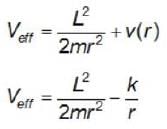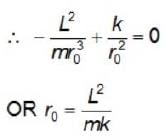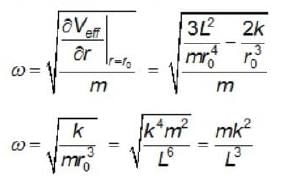GATE Exam > GATE Questions > A planet of mass m and angular momentum L mov...
Start Learning for Free
A planet of mass m and angular momentum L moves in a circular orbit in a potential v(r)=  where k is a positive constant If the planet is slighthy perturbed, find angular frequency of radial oscillation.
where k is a positive constant If the planet is slighthy perturbed, find angular frequency of radial oscillation.
 where k is a positive constant If the planet is slighthy perturbed, find angular frequency of radial oscillation.
where k is a positive constant If the planet is slighthy perturbed, find angular frequency of radial oscillation.- a)

- b)

- c)

- d)

Correct answer is option 'A'. Can you explain this answer?
| FREE This question is part of | Download PDF Attempt this Test |
Verified Answer
A planet of mass m and angular momentum L moves in a circular orbit in...

for stable point (orbit)


Therefore radius of stable circular orbit is
 Angular frequency of oscillation
Angular frequency of oscillation about stable paint

Most Upvoted Answer
A planet of mass m and angular momentum L moves in a circular orbit in...
A

|
Explore Courses for GATE exam
|

|
Similar GATE Doubts
A planet of mass m and angular momentum L moves in a circular orbit in a potential v(r)=where k is a positive constant If the planet is slighthy perturbed, find angular frequency of radial oscillation.a)b)c)d)Correct answer is option 'A'. Can you explain this answer?
Question Description
A planet of mass m and angular momentum L moves in a circular orbit in a potential v(r)=where k is a positive constant If the planet is slighthy perturbed, find angular frequency of radial oscillation.a)b)c)d)Correct answer is option 'A'. Can you explain this answer? for GATE 2024 is part of GATE preparation. The Question and answers have been prepared according to the GATE exam syllabus. Information about A planet of mass m and angular momentum L moves in a circular orbit in a potential v(r)=where k is a positive constant If the planet is slighthy perturbed, find angular frequency of radial oscillation.a)b)c)d)Correct answer is option 'A'. Can you explain this answer? covers all topics & solutions for GATE 2024 Exam. Find important definitions, questions, meanings, examples, exercises and tests below for A planet of mass m and angular momentum L moves in a circular orbit in a potential v(r)=where k is a positive constant If the planet is slighthy perturbed, find angular frequency of radial oscillation.a)b)c)d)Correct answer is option 'A'. Can you explain this answer?.
A planet of mass m and angular momentum L moves in a circular orbit in a potential v(r)=where k is a positive constant If the planet is slighthy perturbed, find angular frequency of radial oscillation.a)b)c)d)Correct answer is option 'A'. Can you explain this answer? for GATE 2024 is part of GATE preparation. The Question and answers have been prepared according to the GATE exam syllabus. Information about A planet of mass m and angular momentum L moves in a circular orbit in a potential v(r)=where k is a positive constant If the planet is slighthy perturbed, find angular frequency of radial oscillation.a)b)c)d)Correct answer is option 'A'. Can you explain this answer? covers all topics & solutions for GATE 2024 Exam. Find important definitions, questions, meanings, examples, exercises and tests below for A planet of mass m and angular momentum L moves in a circular orbit in a potential v(r)=where k is a positive constant If the planet is slighthy perturbed, find angular frequency of radial oscillation.a)b)c)d)Correct answer is option 'A'. Can you explain this answer?.
Solutions for A planet of mass m and angular momentum L moves in a circular orbit in a potential v(r)=where k is a positive constant If the planet is slighthy perturbed, find angular frequency of radial oscillation.a)b)c)d)Correct answer is option 'A'. Can you explain this answer? in English & in Hindi are available as part of our courses for GATE.
Download more important topics, notes, lectures and mock test series for GATE Exam by signing up for free.
Here you can find the meaning of A planet of mass m and angular momentum L moves in a circular orbit in a potential v(r)=where k is a positive constant If the planet is slighthy perturbed, find angular frequency of radial oscillation.a)b)c)d)Correct answer is option 'A'. Can you explain this answer? defined & explained in the simplest way possible. Besides giving the explanation of
A planet of mass m and angular momentum L moves in a circular orbit in a potential v(r)=where k is a positive constant If the planet is slighthy perturbed, find angular frequency of radial oscillation.a)b)c)d)Correct answer is option 'A'. Can you explain this answer?, a detailed solution for A planet of mass m and angular momentum L moves in a circular orbit in a potential v(r)=where k is a positive constant If the planet is slighthy perturbed, find angular frequency of radial oscillation.a)b)c)d)Correct answer is option 'A'. Can you explain this answer? has been provided alongside types of A planet of mass m and angular momentum L moves in a circular orbit in a potential v(r)=where k is a positive constant If the planet is slighthy perturbed, find angular frequency of radial oscillation.a)b)c)d)Correct answer is option 'A'. Can you explain this answer? theory, EduRev gives you an
ample number of questions to practice A planet of mass m and angular momentum L moves in a circular orbit in a potential v(r)=where k is a positive constant If the planet is slighthy perturbed, find angular frequency of radial oscillation.a)b)c)d)Correct answer is option 'A'. Can you explain this answer? tests, examples and also practice GATE tests.

|
Explore Courses for GATE exam
|

|
Suggested Free Tests
Signup for Free!
Signup to see your scores go up within 7 days! Learn & Practice with 1000+ FREE Notes, Videos & Tests.


















